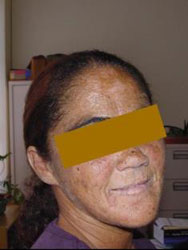Variegate porphyria is the commonest form of porphyria in South Africa. Indeed it is probably the commonest inherited disorder encountered in South Africa.
History
The genealogical studies of Dean and Barnes suggested that the gene for the South African form of variegate porphyria was introduced into South Africa in 1688, when two Dutch settlers, Gerrit Jansz van Deventer and Adriaantje Ariens married in Cape Town. This has now been proven: most South African patients carry a single founder mutation, and haplotype analysis of the ancestral chromosomes has confirmed a relationship with Dutch families with variegate porphyria. In the years following 1688 the gene spread widely through the South African population and is common amongst South Africans of Dutch ancestry, whatever their race or home language.
Enzyme Defect
The defective enzyme is protoporphyrinogen oxidase, which is responsible for the conversion of protoporphyrinogen to protoporphyrin. The defect results in the accumulation of large amounts of protoporphyrin and coproporphyrin, which are typically detectable in faecal samples (See Introduction to porphyria). Accumulation of these porphyrins in the skin is responsible for skin disease. When the haem synthetic pathway is stressed, the precursors ALA and PBG may also accumulate. This is associated with the onset of the acute attack.
Genetic Defect
Both males and females are equally affected, and offspring of an affected parent have a 50% chance of inheriting the defect (See Inheritance of porphyria). Throughout the world, over 100 mutations have been shown to result in defective protoporphyrinogen oxidase activity and variegate porphyria. One mutation, the R59W mutation, represents the founder mutation in the South African population, and accounts for approximately 95% of all patients with variegate porphyria in South Africa. Testing for the R59W mutation is therefore a useful diagnostic test in the South African population. At least nine other mutations are found in South Africa (See Mutations in the PPOX gene in South African familes). Families carrying these mutations test negative for the R59W mutation, and are not related to the large family descended from the original Dutch settlers. Indeed, we have identified a black South African family with non-R59W variegate porphyria.
Clinical Effects
Patients with variegate porphyria may experience both skin disease (See Skin disease in porphyria) and the acute attack (See Acute symptoms in porphyria). The acute attack is now uncommon among patients with variegate porphyria, and skin disease is more frequently encountered. Recent research has shown that only approximately 40% of subjects who inherit variegate porphyria experience any clinical effects: the rest remain silent.
Homozygous Variegate Porphyria
Four cases (two of whom are sisters) have been described in South Africa. All inherited the R59W mutation from one parent and a second, unrelated mutation from the other parent and are therefore compound heterozygotes. Two are extremely severely affected with photosensitivity from birth and neurological and skeletal developmental abnormalities including severe brachydactyly. The other two patients are less affected, but have unusually severe photosensitivity and the same characteristic abnormalities of the fingers though to a lesser degree. Click on the thumbnailat right for more images. Read Homozygous variegate porphyria for more detail.
Diagnosis
The following tests alone or in combination are suitable for the diagnosis of variegate porphyria:
- Positive plasma fluorescence peak at 625 nm on plasma fluoroscanning
- Unequivocal elevation of stool coproporphyrin and protoporphyrin
- Demonstration of a VP-associated mutation in the gene for protoporphyrinogen oxidase (typically the R59W mutation).
Each test has its place. Note however that our laboratory no longer performs faecal porphyrin analysis as an initial part of investigation, and stool samples are therefore not required unless specifically requested by us. Though the stool porphyrin profile is unmistakable in patients who strongly express their VP, it is notoriously unreliable for detection of less-expressed subjects, particularly when used for family screening in asymptomatic family members. It also produces an unacceptable number of false positives. The plasma fluorescence scan has proved both more sensitive and more specific, as well as simpler to perform.
Refer to Diagnosis of porphyria and the two related pages Proving porphyria: patients with suggestive symptoms and Proving porphyria: patients with a family history.
Therapy
Therapy is directed towards amelioration of the skin disease (Read Management of skin disease in porphyria), avoidance of precipitants of the acute attack and rapid and effective intervention for the established acute attack (Management of the acute attack).
Drug Precautions
Full drug precautions are necessary as patients are at risk of the acute attack (See Drug prescription in patients with porphyria).
